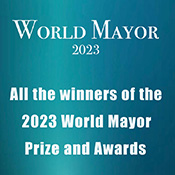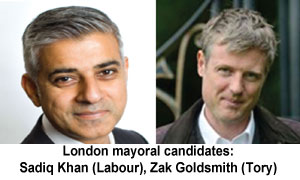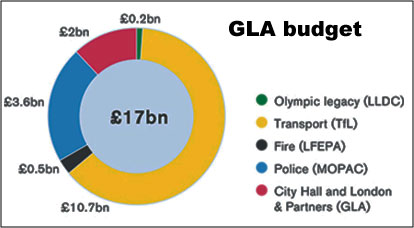
 |
UK politics: London elections 2016 ON THIS PAGE: London prepares for 2016 mayoral and council elections || |
|||||||||||||||||||||||||||||
FRONT PAGE About us   ON OTHER PAGES Mayors COVID-19 Mayors in Europe: Politics & Powers (2019) World's capital cities and their mayors (2020) Salaries of British mayors Salaries of French mayors Salaries of German mayors Salaries of Japanese mayors African American Mayors (2020) Belgian Mayors (2020) British Mayors (2020) Canadian Mayors (2019) French Mayors (2020) German mayors (2019) Indian mayors (2020) Italian mayors (2021) Japanese mayors (2020) Polish mayors (2020) Spanish mayors (2020) Turkish mayors (2019) US mayors (2020) Women in US local government World Mayors and politics Voter turnout - an international comparison Largest cities in the world and their mayors (2017) Largest cities with women mayors (2017) Capital cities and their mayors (2017) |
 London prepares London preparesfor 2016 mayoral and assembly elections By Andrew Stevens 21 October 2015: The fifth elections to the Greater London Authority (both the Mayor of London and the 25 Members of the London Assembly) will be held on May 5 2016. To stand for Mayor of London candidates must be a UK, Irish, Commonwealth or EU citizen aged 18 or over, resident or working in London for at least 12 months and otherwise not disqualified from standing for election. To stand for election, a candidate must pay a returnable (on receiving 5% or more of votes cast) deposit of £10,000 and be nominated by at least 10 electors in each of the 33 local authority areas across Greater London. Voting is under the Supplementary Vote system where electors rank two candidates in order of preference, with preferences reallocated until one candidate has the largest number of votes. The annual salary for the Mayor of London is £143,911, though the current Mayor Boris Johnson has foregone any increase since 2009. Mayoral candidates of registered parties
As noted, the Greater London Authority (GLA) consists of the Mayor of London and the London Assembly, both concurrently elected to fixed four year terms, held on the first Thursday of May (the last election being 3 May 2012). The GLA derives most of its powers from the Greater London Authority Acts 1999 and 2007, as well as the Localism Act 2011. By law, at a minimum, the Mayor must produce seven strategy documents, covering transport, economic development, housing, spatial development (the so-called ‘London Plan’), environment, culture and health inequalities. Each strategy has a number of consultation requirements and statutory procedure (e.g. regard for public health and sustainable development, need to consult the assembly, functional bodies, boroughs, public etc.) and is produced in draft before being finalised. While the GLA’s functional bodies are required to observe these strategies in their own business plans and policies, the Mayor has no formal powers to direct other public bodies to follow them, but is rather expected to facilitate and influence such actions by the boroughs and others through the ‘soft’ or convening power of his office and elected mandate. For instance, the current mayor has established a London Cultural Strategy Group in order to promote and develop his culture strategy among arts organisations and public bodies, while having set a London Living Wage as a benchmark across the GLA and functional bodies, other London-based employers are encouraged to follow suit. The exception here is the London Plan, where since 2007 the Mayor has the power to designate certain planning applications at borough level as of “strategic importance” and to grant/refuse permission by himself (having done so 11 times). While the Mayor is required under the Localism Act 2011 to produce an environmental strategy, he has not yet done so, but has published individual strategies for air, waste, energy and climate change. The Mayor is vested with all executive power in the GLA and may under the 1999 Act individually appoint up to two political advisers and 10 policy advisers. Since 2008 the Mayor has chosen to style some of these as ‘deputy mayors’, even though this post does not exist in law, other than for the Statutory Deputy Mayor who must be appointed from the London Assembly to deputise for the Mayor as required. The current ‘Mayoral team’ consists of the Statutory Deputy Mayor and Deputy Mayors for Housing, Land and Property; Transport; Policing and Crime; Policy and Planning (also Chief of Staff); Education and Culture; and Environment and Energy. There is also a Director of Communications and Mayoral Advisers on Regeneration, Cycling, Mentoring, Economic Policy and Volunteering, as well as a range of unpaid special advisory appointments in the Mayor’s gift. Other appointments for GLA staffing at chief officer level (e.g. Head of Paid Service and Chief Financial Officer) must be done jointly with the Assembly’s Oversight Committee. The GLA has under the 1999 Act a general power of competence as regards its principal purposes and functions, under which the Mayor can secure improvements in the economic, social and environmental aspects of London. Principally the GLA has responsibility for three functional bodies for service delivery in the capital, Transport for London (TfL), the Mayor’s Office for Policing and Crime (MOPAC) and the London Fire and Emergency Planning Authority (LFEPA). Transport for London is the transport authority for Greater London, responsible for the London Underground (tube), some commuter rail services, bus franchising, major roads, taxi licensing, light rail, cycle hire, cable car and river boat services. Its board is appointed and usually chaired by the Mayor, with his Deputy Mayor for Transport as Deputy Chair. The board appoints the Transport Commissioner to lead the management team for TfL and its three directorates (London Underground, London Rail and Surface Transport). It is mainly funded by fares income (40%), grants from the GLA and Department for Transport and own revenue (advertising income, congestion charging and property rental). The Mayor’s Office for Policing and Crime exercises the functions carried out by elected Police and Crime Commissioners outside of Greater London, where the Mayor and, if he chooses, a Deputy Mayor for Policing and Crime performs this role. Aside from the strategy and budgetary functions of the office, operational responsibility for the Metropolitan Police Service remains with the serving Commissioner as lead officer appointed by the Home Secretary in consultation with the Mayor. The London Fire and Emergency Planning Authority is responsible for the London Fire Brigade, as well as emergency planning coordination. The authority consists of 17 members: eight from the London Assembly, seven councillors from the London Boroughs and two mayoral appointees. The London Fire Commissioner is appointed by the authority, which otherwise set its strategy and budget, subject to mayoral oversight. The UK government is currently consulting on reforming the fire function in London alongside other English local areas to abolish LFEPA and instead create a separate mayoral body in the style of MOPAC to oversee fire services in the capital. Following the statutory abolition of the London Development Agency (LDA, created in 1999 alongside the eight other Regional Development Agencies of England) in 2012, GLA Land and Property (GLAP) became a functional body of the GLA for the purposes of managing the property holdings and land assets held by the LDA under the mayor’s economic development and spatial development strategies, as well as the housing duties acquired under the Localism Act 2011 (managing the Homes and Communities Agency’s functions and grants in London). Further regeneration work (e.g. skills and enterprise) is undertaken by the non-statutory London Enterprise Panel, which is one 39 Local Enterprise Partnerships in England, established after the abolition of the regional development agencies. Since 2011 the Mayor has chosen to fund promotional company London & Partners through the GLA in order to undertake tourism and inward investment promotion work on behalf of the capital. The Mayor has also used new powers under the Localism Act to create and appoint two statutory Mayoral Development Corporations (MDCs) with planning powers over designated areas: the London Legacy Development Corporation (LLDC) to manage the former Olympic Park and surrounding area and the Old Oak and Park Royal Development Corporation (OPDC) in West London (an interchange for the HS2 and Crossrail hubs). The GLA Group has an annual budget of around £17bn and receives its principal source of funding through central government grants, the precept on Council Tax collected by the London local authorities, fares and congestion charges collected by Transport for London, Business Rates retention scheme income, the Community Infrastructure Levy on new development and Supplementary Business Rates (to fund Crossrail).  Follow @City_Mayors |